|
Can there be an actor alive who has endured more physical abuse than Bruce Campbell during the course of Evil Dead II, the supercharged sequel to the über-cult 1981 The Evil Dead? In the course of the first 40 minutes, director Sam Raimi throws everything at Campbell, including Campbell himself, in an almost unrelenting blitz of violence against his person. He is barrelled through treetops, dropped face-first into muddy water and facially submerged for just long enough to suggest he may have drowned, showered in blood on which he slips and falls over, bitten by a severed head, punched in the face, somersaulted onto his back, tossed headlong into a cellar and has crockery repeatedly smashed over his head. And that's just a sampler. If I didn't know better, I suspect that Raimi had found his girlfriend in Campbell's bed and was abusing his position as director to make his friend suffer.*
But together with the grooviest tooling-up scene in horror history, it's this incident-packed first half that established Campbell's status as the cult horror actor of his generation. In The Evil Dead he was part of an ensemble cast and emerged as the lead player by virtue of his survival, but here he's the star from the opening minutes, with everyone else either a sidekick or a supporting player. Evil Dead II may well be a Sam Raimi film (and it really is), but it's Bruce Campbell's movie.
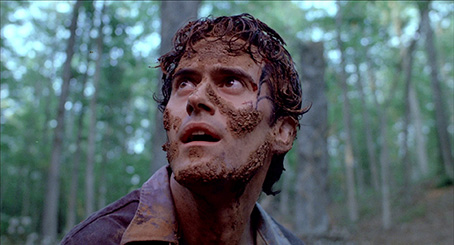
In the wake of the comical buffoonery of Army of Darkness, it's too easy to forget that the original The Evil Dead (the definite article handily differentiates it from the remake) was a genuinely frightening film. It was also, if I remember right, the first feature to be released simultaneously in cinemas and on VHS in the UK. And it's worth recalling that it was in the UK that it first found real favour, having been met with an initially lukewarm response in its native America, despite a wildly enthusiastic review from a certain Stephen King. When it came out over here I was quite seriously ill and being nursed by my sister, and on one of her trips out I asked her to pick up a rental copy of the film. We watched it that afternoon with the curtains drawn and the sound cranked up. I don't think she ever really forgave me.
The Evil Dead was a horror fan's wet dream – it was insanely gory, nail-bitingly tense, had horrible make-up, a terrifying soundtrack and camerawork of the like we had never seen. It took another couple of viewings for many of us to appreciate its sometimes jet-black humour, in part because Raimi put his comedy influences to such unsettling use. When the possessed Linda sits and smiles like a demented clown and sings "we're gonna get you..." in the sing-song tones of a nursery rhyme, it should be funny but is actually deeply disturbing, tapping as it does into a range of childhood and even adult terrors. And even in the midst of the wildest cackling there are moments that really do chill to the bone. My personal favourite comes when the demonically transformed Cheryl furiously taunts Ash from the basement in which she has been confined with the warning: "Soon all of you will be like me, and then who will lock you up in the cellar?"
Evil Dead II is a sequel that, in a breathlessly compact prologue, effectively re-imagines how the first film played out. In this version Ash travels alone with girlfriend Linda to the cabin in which the pair are attacked by demonic forces. This rethink of events apparently confused some slower viewers on the film's initial release, who could not understand why Ash would return to the cabin in which he had already been so horribly tormented. Oh please. If all this means nothing to you then you owe it to yourself to see The Evil Dead before approaching this one or even reading any more of this review.
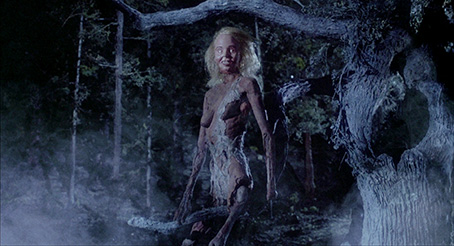
If you need reminding of the set-up, then here's a quick summary. Young and good-looking Ash takes his girlfriend Linda to a cabin in the woods for a quiet romantic weekend, and while there discovers a tape recorder on which the owner of the cabin – one Professor Raymond Knowby – has recorded his translation of the Book of the Dead. When Ash plays the tape, dark forces are awakened in the woodland surrounding the cabin and take possession of Linda, with whom Ash is forced to do lethal battle. Then just when he thinks the danger is over, the demon in the woods hurtles towards and through the cabin and right into Ash's screaming mouth. And that's just the prologue. It's at this moment that Evil Dead II really kicks off. We had assumed Ash was killed at the end of the first film, a familiar post-Night of the Living Dead rug-pull that is executed with such astonishing visual panache that it really did play like we'd never seen it before. Under normal circumstances to then reveal that Ash actually survived this assault would feel a little like a Saturday morning serial cheat, any thoughts of which a blown asunder by the sheer kinetic energy of the shot that immediately follows, as Ash is hurtled through treetops at a dizzying speed by an unseen force, rotating as he flies and battered by branches. As he collides with a tree trunk and the camera spirals to earth in a dizzying POV, there's a real sense that this extraordinary sequence – purposeful though every stylised shot may be – is designed as an announcement that the second film is now under way and that the normal rules of filmmaking and even horror storytelling are strictly for the birds.
As Annie, the archaeologically inclined daughter of Professor Knowby, makes her way to the cabin carrying the missing pages of the Book of the Dead with boyfriend Ed and local hicks Jake and Bobby Joe in tow, Ash returns to the cabin for the most punishing night of his life. And despite being essentially a one-man show, it's dynamite stuff, a string of visually and aurally kinetic show-stoppers in which our hero does battle with unseen forces, his mischievously possessed right hand and his own crumbling sanity. Its here that Raimi's fondness for slapstick is at its most evident (though a portion of its early audience, including a few of those involved in its making, were still unsure whether they were supposed to be laughing), as Ash's possessed and eventually severed hand smashes crockery over his head, hurls him to the floor, then scurries around the cabin like a nervous rodent, flipping him the finger and stumbling into a mousetrap, prompting its former owner to let out a single, perfectly pitched bark of laughter. Though a good deal of fun, this does distance the film from reality just enough to soften its effectiveness as an all-out frightener. That it still delivers more than its share of serious wind-ups is a testament to how closely and quickly we bond with Ash and the unbridled energy of Raimi's direction. And there's a dark side to even the wildest comedy here – as the fittings of the cabin come to life and begin giggling wildly, prompting a wide-eyed Ash to laugh along with them, the comic overtones of the scene are underscored by a very real sense of a man losing a battle with encroaching madness.
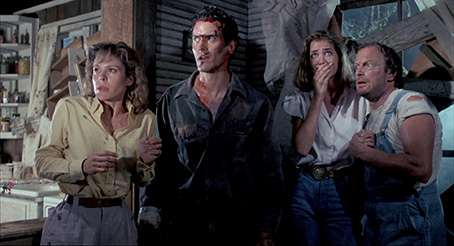
Evil Dead II was Raimi's third feature and Campbell's fourth professional acting gig and the two had clearly learned a lot in the five years that passed between the first film and its sequel. Mind you, they were working with ten times the budget of The Evil Dead and were thus able to shoot on 35mm, build controllable interior sets instead of having to rough it in the woods, and hire an experienced makeup effects crew and up-and-coming cinematographer Peter Deming (later to lens a number of celebrated features including Lost Highway, Mulholland Drive, the Austin Powers movies, Scream 2, 3 and 4 and wouldn't you just know it, Cabin in the Woods). And while it can't quite recapture the sheer drive and don't-give-a-shit freshness of its still electrifying predecessor, it comes pretty damned close.
This is rock 'n' roll horror for the post-punk era, one that melds a new wave energy and youthful brashness with a string of pop culture influences, from the fantasy movies of Ray Harryhausen to Raimi's love of comic books and Three Stooges comedies.** There really is a sense of an auteur at work here, as Raimi conducts his enthusiastic crew like a composer who has swallowed a bag full of amphetamines, making furious but consistently exciting music with his camera, effects, performances, soundtrack and editing. And like all great rock it has built a devoted following and stood the test of time, in part because no other bugger has shown the right combination of talent and brass balls to even attempt what Raimi and his collaborators pull off here.
Not everything hits gold. There's a fair amount of recycling from the previous movie, and the perceived need to jazz it up in every respect results in the climactic visualisation of a monster that was far more effective when left unseen (the mechanically flapping lower jaw doesn't help), and the subsequent arrival of the more comically inclined Army of Darkness makes easy to forget how audacious and downbeat the ending here once seemed. But Evil Dead II still hits a near-perfect balance of horror and comedy, resulting in a quintessential cult film that remains to this day one of the wittiest, smartest and most exciting genre works of modern times, and more genuine fun than anything even Raimi himself has delivered since.
Initial impressions of this sparkly new HD transfer – which I gather was licensed from the 2011 Lionsgate US release, which itself was mastered from the original camera negative – are extremely favourable, particularly when compared to the earlier Anchor Bay DVD and even the previous Optimum Blu-ray. The contrast is punchy, despite some visible black crush, the detail impressive and the colours often vivid – compare it directly with the earthy tones of the DVD transfer and it genuinely looks like a different film. In many respects an excellent transfer – I certainly don't remember the film ever looking as good as this – but there's occasionally a slight waxiness to faces that suggests the film has been subjected to some low level DNR (of course this could be down to the makeup...), and there were times when the picture feels almost too luminous for a low budget, night-set horror film (the screen grabs here don't reflect how vibrant it looks on screen). Film grain is still visible, which is always a good sign, and on the first shot of Linda dancing in the prologue it's a lot more pronounced than on the surrounding footage. But these are small gripes for what is otherwise a generally fine job that should have fans hugging themselves with glee. Research suggests that a couple of instances of visible wires on physical effects have been digitally removed for this transfer, which may irk purists. The increased definition has also made some other effects, including the matte painting of the wrecked bridge, more visible for what they are, but I am quite happy for them to remain that way.
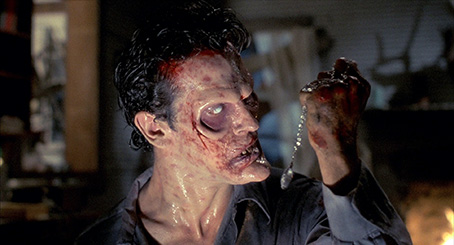
The DTS-HD Master Audio soundtrack choice is between stereo 2.0 and surround 5.1 (I seem to remember that the original was mono, but maybe I'm wrong). Both are in good shape with a solid dynamic range; the stereo seems to have a tad more treble, while the 5.1 has more bass. Separation is occasionally quite pronounced on both tracks, and the visually distorted sequence in which strange noises dart about the cabin makes use of the full surround stage.
Audio Commentary
If you own the Anchor Bay DVD you'll already be familiar with the commentary track here, but that doesn't matter a jot. Director and co-writer Sam Raimi, co-writer Scott Spiegel, leading man Bruce Campbell and special effects makeup artist Greg Nicotero were clearly still close friends when this was recorded (and I'm sure they still are) and the resulting banter is lively, entertaining and genuinely instructive. There are recollections aplenty of the shoot itself and explanations about how a number of effects were achieved. There's also a good deal of mutual piss-taking, particularly of Campbell, who cheerfully joins in the ribbing of his own performance. Like the film itself, this is fast paced and fun.
Swallowed Souls: The Making of Evil Dead II (98:14)
Yep, this is one of those rare retrospective documentaries whose running time exceeds that of the main feature, one that can be watched as a complete package or as individually titled chapters, each headed with a neat animated sequence based on the film. The areas covered include the cast, the effects, the director, the animation and the initial response to the finished film, all in enthralling detail. Just about every key player in the film's production is interviewed – although Raimi and Robert Tapert are conspicuous by their absence – and their detailed recollections are peppered with behind-the-scenes footage shot by makeup effects artist Greg Nicoreto. Particularly revealing is the chapter on the makeup effects team, who come across more as members a frat house than a professional film crew – they clearly knew their stuff, but seem to have spent almost every spare minute creatively arsing about. "Imagine if the guys that are on the show Jackass were makeup effects artists" offers one of them by way of explanation, while another suggests "You just don't give makeup effects guys in the 80s their own vehicle and trust them with anything." This was clearly the team to be working with. One of the nicest observations comes from Bruce Campbell, who celebrates the film's small imperfections and suggests that modern films have become over-polished and don't feel organic. Absolutely.
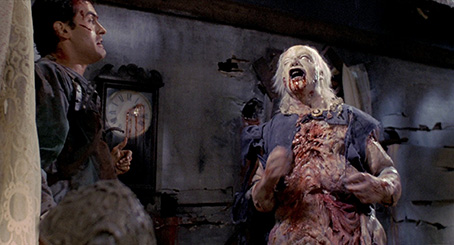
Cabin Fever (30:23)
A valuable collection of footage, all shot by Greg Nicoreto, of the creation and implementation of a four of the key makeup effects, namely Henrietta, Evil Ed, possessed Ash and possessed Linda. There is also some footage of the shooting of sequences that never made into the final cut. Fascinating stuff.
Photo Galleries
Four slightly anaemic photo galleries containing between 17 and 30 photos apiece, titled Ads and Memorabilia, Behind the Scenes, Special Makeup Effects and Stop Motion Animation.
Archival Footage
This is divided in three titled sections. Behind the Screams (17:07) is a rolling photo gallery of stills taken during the shoot with a commentary by their author, animator Tom Sullivan, and proves a lot more interesting than the straight photo galleries above. The Gore the Merrier (31:52) is an interview with makeup effects artists Robert Kurtman, Howard Berger and Greg Nicotero, whose recollections of the shoot are illustrated by more of Nicoreto's behind-the-scenes footage, some of which is unique to this extra, including a Re-Animator inspired "Evil Dead Baby" gag at the end. Finally there's the original Theatrical Trailer, which is in surprisingly good shape.
Road to Wadesboro (8:10)
Filmmaker Tony Elwood, who was responsible for "special props" on Evil Dead II, revisits the locations on which the film was shot. Surprisingly (even to him), the tool shed and cabin that they built are still standing, albeit in a somewhat dilapidated state.
As far as I can ascertain, this Special Edition Blu-ray from Studiocanal is a UK release of the Lionsgate 25th Anniversary Edition from 2011, but that's no bad thing, particularly if your Blu-ray player is locked to region B. A generally excellent transfer and a fine collection of extra features make this an absolute must-have for fans of the film, eclipsing as it does all previous home video versions by a sizeable amount. Horribly recommended.
* Having written the above, I was caught out when watching the Swallowed Souls documentary to hear one of the crew offer almost the same suggestion for why Sam so tortures Bruce.
** In Raimi's early films you'll often find a bit player credited as "Shemp" after the Three Stooges' Shemp Howard, whose scenes in four shorts were completed using previously shot footage after he died of a heart attack. There are a number of "Fake Shemps" in the first two Evil Dead movies, a "Final Shemp" in Darkman and a "Wedding Shemp" in The Quick and the Dead. The last two were both played by Bruce Campbell.
|